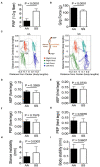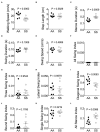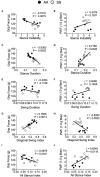Spatiotemporal Alterations in Gait in Humanized Transgenic Sickle Mice
- PMID: 33178189
- PMCID: PMC7593487
- DOI: 10.3389/fimmu.2020.561947
Spatiotemporal Alterations in Gait in Humanized Transgenic Sickle Mice
Abstract
Sickle cell disease (SCD) is a hemoglobinopathy affecting multiple organs and featuring acute and chronic pain. Purkinje cell damage and hyperalgesia have been demonstrated in transgenic sickle mice. Purkinje cells are associated with movement and neural function which may influence pain. We hypothesized that Purkinje cell damage and/or chronic pain burden provoke compensatory gait changes in sickle mice. We found that Purkinje cells undergoe increased apoptosis as shown by caspase-3 activation. Using an automated gait measurement system, MouseWalker, we characterized spatiotemporal gait characteristics of humanized transgenic BERK sickle mice in comparison to control mice. Sickle mice showed alteration in stance instability and dynamic gait parameters (walking speed, stance duration, swing duration and specific swing indices). Differences in stance instability may reflect motor dysfunction due to damaged Purkinje cells. Alterations in diagonal and all stance indices indicative of hesitation during walking may originate from motor dysfunction and/or arise from fear and/or anticipation of movement-evoked pain. We also demonstrate that stance duration, diagonal swing indices and all stance indices correlate with both mechanical and deep tissue hyperalgesia, while stance instability correlates with only deep tissue hyperalgesia. Therefore, objective analysis of gait in SCD may provide insights into neurological impairment and pain states.
Keywords: gait; histopathology; hyperalgesia; purkinje cell; sickle cell disease.
Copyright © 2020 Kiven, Wang, Aich, Argueta, Lei, Sagi, Tennakoon, Bedros, Lambrecht and Gupta.
Figures






Similar articles
-
Pain in sickle cell disease: current and potential translational therapies.Transl Res. 2021 Aug;234:141-158. doi: 10.1016/j.trsl.2021.03.007. Epub 2021 Mar 9. Transl Res. 2021. PMID: 33711512 Free PMC article. Review.
-
Comparative Analysis of Pain Behaviours in Humanized Mouse Models of Sickle Cell Anemia.PLoS One. 2016 Aug 5;11(8):e0160608. doi: 10.1371/journal.pone.0160608. eCollection 2016. PLoS One. 2016. PMID: 27494522 Free PMC article.
-
Antisickling fetal hemoglobin reduces hypoxia-inducible factor-1α expression in normoxic sickle mice: microvascular implications.Am J Physiol Heart Circ Physiol. 2013 Jan 1;304(1):H42-50. doi: 10.1152/ajpheart.00296.2012. Epub 2012 Nov 2. Am J Physiol Heart Circ Physiol. 2013. PMID: 23125209 Free PMC article.
-
Pain-related behaviors and neurochemical alterations in mice expressing sickle hemoglobin: modulation by cannabinoids.Blood. 2010 Jul 22;116(3):456-65. doi: 10.1182/blood-2010-01-260372. Epub 2010 Mar 19. Blood. 2010. PMID: 20304807 Free PMC article.
-
Sensitization of nociceptors and dorsal horn neurons contributes to pain in sickle cell disease.Neurosci Lett. 2019 Jul 13;705:20-26. doi: 10.1016/j.neulet.2019.04.013. Epub 2019 Apr 14. Neurosci Lett. 2019. PMID: 30995520 Free PMC article. Review.
Cited by
-
Spatial genomics of AAV vectors reveals mechanism of transcriptional crosstalk that enables targeted delivery of large genetic cargo.Nat Biotechnol. 2025 Mar 20. doi: 10.1038/s41587-025-02565-4. Online ahead of print. Nat Biotechnol. 2025. PMID: 40113953
-
Vascular smooth muscle cell-specific Igf1r deficiency exacerbates the development of hypertension-induced cerebral microhemorrhages and gait defects.Geroscience. 2024 Jun;46(3):3481-3501. doi: 10.1007/s11357-024-01090-7. Epub 2024 Feb 23. Geroscience. 2024. PMID: 38388918 Free PMC article.
-
Sickle cell disease as an accelerated aging syndrome.Exp Biol Med (Maywood). 2022 Feb;247(4):368-374. doi: 10.1177/15353702211068522. Epub 2022 Feb 16. Exp Biol Med (Maywood). 2022. PMID: 35172625 Free PMC article. Review.
-
Investigating the effects of global gene knockout of MrgF on motor performance and pain sensitivity in mice.Hereditas. 2025 Mar 3;162(1):31. doi: 10.1186/s41065-025-00377-9. Hereditas. 2025. PMID: 40033362 Free PMC article.
-
Pain in sickle cell disease: current and potential translational therapies.Transl Res. 2021 Aug;234:141-158. doi: 10.1016/j.trsl.2021.03.007. Epub 2021 Mar 9. Transl Res. 2021. PMID: 33711512 Free PMC article. Review.
References
Publication types
MeSH terms
Substances
Grants and funding
LinkOut - more resources
Full Text Sources
Medical
Molecular Biology Databases
Research Materials

